Students must practice these TS Intermediate Maths 1B Solutions Chapter 1 Locus Ex 1(a) to find a better approach to solving the problems.
TS Inter 1st Year Maths 1B Locus Solutions Exercise 1(a)
Question 1.
Find the equation of locus of a point which is at a distance 5 from A (4, – 3). (V.S.A.Q)
Answer:
Given A = (4, – 3) and suppose P (x, y) is any other point on the locus.
Then given PA = 5
⇒ PA2 = 25
⇒ (x – 4)2 + (y + 3)2 = 25
⇒ x2 + y2 – 8x + 6y + 25 – 25 = 0
⇒ x2 + y2 – 8x + 6y = 0 ……………… (1)
(If there exists another point Q(x1, y1) such that QA2 = (x1 – 4)2 + (y1 + 3)2
Let Q(x1, y1 satisfy (1) then
x12 + y12 – 8x1 + 6y1 = 0
and QA2 = x12 + y12 – 8x1 + 6y1 + 25
= 0 + 25 = 25
⇒ QA = 5
∴ Q (x1, y1) satisfy the geometric condition (1)
∴ Required equation of locus is x2 + y2 – 8x + 6y = 0
Note : Second part need not follow the problem from the definition of locus.
![]()
Question 2.
Find the equation of locus of a point which is equidistant from the points A (-3, 2) and B (0, 4). (V.S.A.Q)
Answer:
Let P (x, y) be any point on the locus. Then from the given geometric condition PA = PB
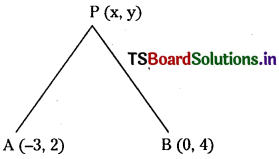
∴ PA2 = PB2
⇒ (x + 3)2 + (y – 2)2 = (x – 0)2 + (y – 4)2
⇒ x2 + y2 + 6x + 9 – 4y + 4 = x2 + y2 – 8y + 16
⇒ 6x + 4y – 3 = 0
⇒ 6x + 4y = 3 is the equation of the locus.
Question 3.
Find the equation of locus of a point P such that the distance of P from the origin is twice the distance of P from A (1, 2).
(V.S.A.Q) (March 2012)
Answer:
Given O (0,0) and A (1,2) are the two points, P (x, y) be any point on the locus. From the given condition OP = 2PA
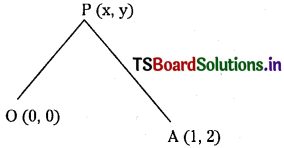
⇒ OP2 = 4 PA2
⇒ x2 + y2 = 4[(x – 1)2 + (y – 2)2]
⇒ x2 + y2 = 4 [(x2 + y2 – 2x – 4y + 1 + 4]
⇒ 4 [x2 + y2 – 2x – 4y + 5]
⇒ 4x2 + 4y2 – 8x – 16y + 20
∴ Equation to the locus of P is
3x2 + 3y2 – 8x – 16y + 20 = 0
Question 4.
Find the equation of locus of a point which is equidistant from the coordinate axes. (V.S.A.Q)
Answer:
Let P (x, y) be any point on the locus.
The distance from P to X – axis is ’y and that of the distance to Y – axis is ‘x’.
Given y = x ⇒ y2 = x2
locus of P (x, y) is x2 – y2 = 0
![]()
Question 5.
Find the equation of locus of a point equidistant from A (2, 0) and the Y – axis. (V.S.A.Q)
Answer:
A (2, 0) is the given point and
Let P (x, y) be any point on the locus.
The distance from P to Y – axis is PB = x
Given PA = PB
⇒ PA2 = PB2
⇒ (x – 2)2 + y2 = x2
⇒ x2 – 4x + 4 + y2 = x2
⇒ y2 – 4x + 4 = 0
∴ Locus of P (x, y) is y – 4x + 4 = 0
Question 6.
Find the equation of locus of a point P the square of whose distance from the origin is 4 times its y – coordinate. (V.S.A.Q)
Answer:
Let P (x, y) be any point on the locus. Its distance from origin is OP
Given that OP2 = 4y
⇒ x2 + y2 = 4y
⇒ x2 + y2 – 4y = 0
∴ Equation to the locus of P is
x2 + y2 – 4y = 0
Question 7.
Find the equation of locus of a point P Such that PA2 + PB2 = 2c2 where A = (a, 0), B= (- a, 0) and 0 < |a| < |c| (V.S.A.Q)
Answer:
Let P (x, y) be any point on the locus. Given A = (a, 0) and B = (-a, 0) are two points. Given condition is PA2 + PB2 = 2c2
⇒ (x – a)2 + y2 + (x + a)2 + y2 = 2c2
⇒ x2 – 2ax + a2 + y2 + x2 + 2ax + a2 + y2 = 2c2
⇒ 2x2 + 2y2 = 2c2 – 2a2
∴ x2 + y2 = c2 – a2 is the equation of locus of P.
II.
Question 1.
Find the equation of locus of P, if the line segment joining (2, 3) and (-1,5) subtends a right angle at P. (May ’12, March ’13, ’05) (S.A.Q)
Answer:
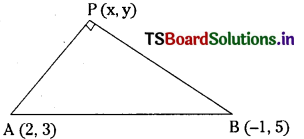
A = (2, 3), B = (-1, 5) are the given points. P (x, y ) is any point on the locus.
Given condition is ∠APB = 90°
Using pythagorous theorem, AP2 + PB2 = AB2
⇒ (x – 2)2 + (y – 3)2 + (x + 1)2 + (y – 5)2 = ( 2 + 1)2 + ( 3 – 5)2
⇒ x22 – 4x + 4 + y2 – 6y + 9 + x2 + 2x + 1 + y2 – 10y + 25 = 9 + 4
⇒ 2x2 + 2y2 – 2x – 16y + 26 = 0
∴ Locus of P is x2 + y2 – x – 8y + 13 = 0
(x, y) ≠ (2, 3) and (x, y) ≠ (-1,5)
![]()
Question 2.
The ends of the hypotenuse of a right angled triangle are (0, 6 ) and ( 6, 0 ). Find the equation of locus of its third vertex. (S.A.Q)
Answer:
The ends of the hypotenuse are given as A (0, 6) and B (6, 0)
Let P (x, y) be the third vertex.
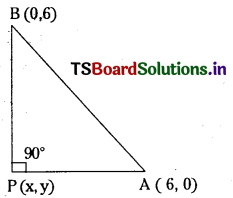
Given condition is ∠APB = 90°
∴ By pythagorous theorem
⇒ AP2 + PB2 = AB2
⇒(x – 0)2 + (y – 6)2 + (x – 6)2 + (y – 0)2 = (0 – 6)2 + (6 – 0)2
⇒ 2x2 + 2y2 – 12y – 12x + 36 + 36 = 36 + 36
⇒ 2x2 + 2y2 – 12x – 12y = 0
∴ Locus of P (x, y) is x2 + y2 – 6x – 6y = 0
(x, y) ≠ (0, 6) and (x, y) ≠ (6, 0)
Question 3.
Find the equation of locus of a point the difference of whose distances from (- 5, 0) and (5, 0) is 8. (May 2011,’06, March 2001) (S.A.Q)
Answer:
A (- 5, 0) and B (5, 0) are the given points.
Let P (x, y) be a point on the locus.
From the given condition |PA – PB| = 8 …… (1)
Consider
PA2 – PB2 = [(x + 5)2 + (y – 0)2] – [(x – 5)2 + (y – 0)2]
= (x2 + 10x + 25 + y2) – (x2 – 10x + 25 + y2) = – 20x
∴ (PA + PB) (PA – PB) = 20x
⇒ (PA + PB) (8) = 20x
⇒ PA + PB = \(\frac{5}{2}\) x .
Adding (1) and (2)
2PA = 8 + \(\frac{5 x}{2}\)x
⇒ 4PA = 16 – 5x
⇒ 16 PA = (16 – 5x)2
⇒ 16 [(x + 5)2 + y2] = (16 + 5x)2
⇒ 16 [x2 + y2 + 10x + 25] = (16 + 5x)2
⇒ 16x2 + 16y2 + 160x + 400 = 256 + 160x + 252
⇒ 9x2 + 16y2 + 144 = 0
⇒ 9x2 – 16y2 = 144
⇒ \(\frac{9 x^2}{144}-\frac{16 y^2}{144}\) = 1
⇒ \(\frac{x^2}{16}-\frac{y^2}{9}\) = 1
∴ Equation of locus of P(x, y) is \(\frac{x^2}{16}-\frac{y^2}{9}\) = 1
Question 4.
Find the equation of locus of P, if
A = (4, 0), B = (- 4, 0) and |PA – PB| = 4. (S.A.Q) (May’ 2007)
Answer:
Given that A = (4, 0) and B = (- 4, 0) are two points and let P (x ,y) be any point on the locus.
The given condition is |PA – PB| = 4 ………………. (1)
Consider
PA2 – PB2 = [(x – 4)2 + y2] – [(x + 4)2 + y2]
= (x2 – 8x + 16 + y2) – (x2 + y2 + 8x + 16)
= – 16x
(PA + PB) (PA – PB) = – 16x
⇒ (PA + PB) (4) = -16x
⇒ PA + PB = – 4x ……………….. (2)
Adding (1) and (2)
2PA = 4 – 4x
⇒ PA = 2 – 2x
⇒ PA2 = (2 – 2x)2
⇒ (x – 4)2 + y2 = 4 – 8x + 4x2
⇒ x2 + y2 – 8x + 16 = 4x2 – 8x + 4
⇒ 3x2 – y2 = 12
⇒ \(\frac{x^2}{4}-\frac{y^2}{12}\) = 1
∴ Equation to the locus of P is \(\frac{x^2}{4}-\frac{y^2}{12}\) = 1
![]()
Question 5.
Find the equation of locus of a point, the sum of whose distances from (0, 2) and (0, – 2) is 6 . (S.A.Q)
Answer:
Let A = (0, 2) and B = (0, – 2) are the two given points.
Let P (x, y) b.e any point on the locus.
From the given condition, PA + PB = 6 …………….. (1)
Consider
PA2 – PB2 = [(x – 0)2 + (y – 2)2] – [(x – 0)2 + (y + 2)2]
= x2 + y2 – 4y + 4 – x2 – y2 – 4y – 4 = – 8y
∴ (PA + PB) (PA – PB) = – 8y
⇒ 6 (PA – PB) = – 8y
⇒ (PA – PB) = \(\frac{-8 y}{6}=\frac{-4 y}{3}\) ………………… (2)
Adding (1) and (2)
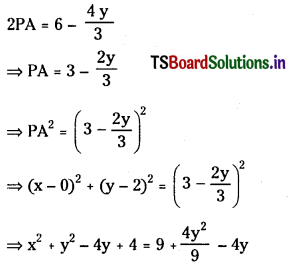
⇒ 9x2 + 9y2 + 36 = 81 + 4y2
⇒ 9x2 + 5y2 = 45
⇒ \(\frac{x^2}{5}+\frac{y^2}{9}\) = 1
∴ Equation to the locus of P is \(\frac{x^2}{5}+\frac{y^2}{9}\) = 1
Question 6.
Find the equation of the locus of P, if A = ( 2, 3 ), B = ( 2, -3 ) and PA + PB = 8. (SA.Q)
Answer:
Let P (x, y ) be any point on the locus.
Given condition is PA + PB = 8 (1)
PA2 – PB2 = [(x – 2)2 + (y – 3)2] – [ (x – 2)2 + ( y + 3)2]
= (x – 2)2 + (y – 3)2 – (x – 2)2 – (y + 3)2 = – 12y
(y – 3)2 – (y + 3)2 = – 12y
∴ PA2 – PB2 = – 12y
(PA + PB) (PA – PB) = -12y
⇒ 8 (PA – PB) = – 12y
⇒ PA – PB = \(\frac{-12 y}{8}=\frac{-3 y}{2}\) ……………….. (2)
Adding (1) and (2)
2PA = 8 – \(\frac{3 \mathrm{y}}{2}\) = \(\frac{16-3 y}{2}\)
⇒ 4PA = 16 – 3y
⇒ 16PA2 = (16 – 3y)2
⇒ 16 [(x – 2)2 + (y – 3)2] = (16 – 3y)2
⇒ 16 [x2 + y2 – 4x – 6y + 13] = 256 – 96y + 9y2
⇒ 16x2 + 7y2 – 64x – 48 = 0
∴ Equation to the locus of P is
16x2 + 7y2 – 64x – 48 = 0
(or) 16(x2 – 4x) + 7y2 = 48
⇒ 16 (x2 – 4x + 4) + 7y2 = 112
⇒ 16 (x – 2)2 + 7y2 = 112.
⇒ \(\frac{(x-2)^2}{7}+\frac{y^2}{16}\)
![]()
Question 7.
A (5, 3) and B (3, – 2) are two fixed points. Find the equation to the locus of P, so that the area of triangle PAB is 9. (S.A.Q) (March 2006)
Answer:
A (5, 3 ), B (3, -2 ) are the given points.
Let P (x, y ) be any point on the locus. Given condition is that the area of ∆ PAB = 9
⇒ \(\frac{1}{2}\) |[x1 (y2 – y3) + x2 (y3 – y1) + x3 (y1 – y2)[|
= \(\frac{1}{2}\) |[5(- 2 – y) + 3 (y – 3) + x (3 + 2)]| = 9
⇒ 5x – 2y – 19 = ±18
⇒ 5x – 2y – 19 = 18 (or) 5x – 2y – 19 = – 18
⇒ 5x – 2y – 37 = 0 (or) 5x – 2y – 1= 0
∴ Locus of P is (5x – 2y – 37) (5x – 2y – 1) = 0
Question 8.
Find the equation of locus of a point, which forms a triangle of area 2 with the points A (1, 1 ) and B ( – 2, 3 ). (S.A.Q)
Answer:
A ( 1, 1), B(- 2, 3 ) are the two given points and Let P ( x, y ) be any point on the locus.
Given condition is ∆ PAB = 2
⇒ ∴ \(\frac{1}{2}\) |1(3 – y) – 2(y – 1) + x(1 – 3)| = 2
⇒ |3 – y – 2y + 2 – 2x| = 4
⇒ – 2x – 3y + 5 = ±4
⇒ – 2x – 3y + 5 = 4 (or) – 2x – 3y + 5 = – 4
⇒ 2x + 3y – 1 = 0 (or) 2x + 3y – 9 = 0
∴ Locus of P (x, y) is (2x + 3y – 1) (2x + 3y – 9) = 0
Question 9.
If the distance from P to the points (2, 3) and ( 2, – 3 ) are in the ratio 2 : 3 then find the equation of locus of P. (S.A.Q) (May 2014, March 2014)
Answer:
Let P (x, y ) be any point on the locus.
Given points are A (2, 3) and B (2, -3) and given condition is PA : PB = 2: 3
⇒ 3PA = 2PB ⇒ 9PA2 = 4PB2
⇒ 9 [(x – 2)2 + (y – 3)2] = 4 [(x – 2)2 + (y + 3)2]
⇒ 9 [(x2 – 4x + 4 + y2 – 6y + 9)] = 4 [x2 – 4x + 4 + y2 + 6y + 9]
⇒ 5x2 + 5y2 – 20x – 78y + 65 = 0
∴ Equation to the locus of P is
5x2 + 5y2 – 20x – 78y + 65 = 0
Question 10.
A (1, 2 ), B ( 2, – 3) and C (- 2, 3) are three points. A point P moves such that PA2 + PB2 = 2PC2. Show that the equation to the locus of P is 7x – 7y + 4 = 0 (S.A.Q) (May 2007)
Answer:
Let P (x, y) be any point on the locus. Given points are
A = (1, 2) ; B = (2, – 3) and C = (- 2, 3)
Given condition is PA2 + PB2 = 2PC2
⇒[(x – 1)2 + (y – 2)2] + [(x – 2)2 + (y + 3)2]
= 2 [(x + 2)2 + (y – 3)2]
⇒ 2x2 + 2y2 – 6x + 2y + 18
= 2x2 + 2y2 + 8x – 12y + 26
⇒ 14x – 14y + 8 = 0
⇒ 7x – 7y + 4 = 0
∴ Equation to the locus of P is
7x – 7y + 4 = 0